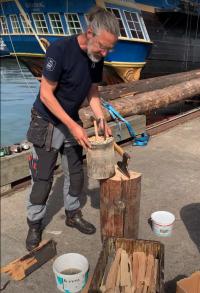 Before chemical or petroleum-based sealants, tar made from pine trees had a myriad of uses; from protecting hemp ropes, lines, and cable from rot; to waterproofing canvas; for preserving wood; to being used as an antiseptic in chronic skin conditions. It was also known as Stockholm tar because a single company held a royal monopoly on its export out of Stockholm, Sweden.
Before chemical or petroleum-based sealants, tar made from pine trees had a myriad of uses; from protecting hemp ropes, lines, and cable from rot; to waterproofing canvas; for preserving wood; to being used as an antiseptic in chronic skin conditions. It was also known as Stockholm tar because a single company held a royal monopoly on its export out of Stockholm, Sweden.
In the 17th century, the Royal Navy bought most of its tar from Sweden, shifting in the 18th century to importing from its North American colonies, primarily from the Carolinas. British sailors whose hands would become stained by handling tarred lines became known as “tars.” Residents of North Carolina, where tar was produced, became known as “tar heels.”
But how does one make tar from pine? Here is a short video demonstrating how to make tar and turpentine on the dock next to the Swedish ship Götheborg. The Götheborg is a replica of a Swedish East India Company ship, which sank outside Gothenburg in 1745.

Absolutely fascinating, l will definitely try to make some Stockholm tar myself,many thanks for sharing👍
In my youth tar was readily available on sandy beaches and probably still is.